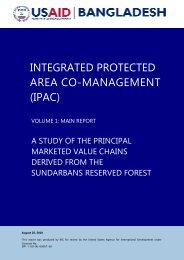Child Equity Atlas - BIDS
Child Equity Atlas - BIDS
Child Equity Atlas - BIDS
You also want an ePaper? Increase the reach of your titles
YUMPU automatically turns print PDFs into web optimized ePapers that Google loves.
<strong>Child</strong> <strong>Equity</strong> <strong>Atlas</strong><br />
7.4 Progress has been Least in the Most<br />
Deprived Areas<br />
7.4.1 The generational progress of literacy was<br />
examined by comparing the youth literacy rate<br />
with that of the adult literacy rates in Bangladesh.<br />
The average un-weighted average difference<br />
between the two rates was 23.9 per cent. It<br />
indicates that Bangladesh made a good progress<br />
within a generation. This remarkable national<br />
progress has not been across the sub national<br />
areas of Bangladesh, as the lowest progress has<br />
been recorded in the most deprived upazilas<br />
where more advancement is most needed to<br />
narrow the equity gap.<br />
findings inform their investment cases, policy<br />
actions, programme targeting and designs and<br />
budgetary appropriations of today. In conclusion,<br />
tracking the identification, removal and reporting<br />
of the obstacles that hinder children, youth and<br />
women from being included in the rapid economic<br />
growth should be the development priority of the<br />
Government of Bangladesh and its development<br />
partners, as articulated in the Sixth Five Year Plan.<br />
7.4.2 The average improvement of the 50 highest<br />
deprived upazilas was just 17.7 percentage points.<br />
Only one of the 50 highest deprived upazilas had<br />
above average progress and 49 upazilas had below<br />
average progress. This indicates that the highest<br />
deprived upazilas need special attention, justifying<br />
the geographic targeting approach adopted by<br />
the Government of Bangladesh in the UNICEF<br />
(and UNDAF) assisted Country Programme of<br />
cooperation 2012-2016. In Bangladesh, the areas<br />
with the highest deprivation tend to be both the<br />
least accessible (hill districts for example) and most<br />
densely populated (urban slums) areas. Therefore,<br />
in order to reduce inequality and achieve Vision<br />
2021 with justice, the most deprived areas should<br />
be given due priority to ensure effective coverage<br />
of basic social services.<br />
7.4.3 The quality of growth in Bangladesh remains<br />
challenged by the continued existence of these<br />
pockets of social exclusion. Instead of waiting for<br />
the results of the 2021 census to again confirm the<br />
historical deprivations revealed in these pockets<br />
of poverty, we call on all stakeholders to let these<br />
Photo : Ibrahim Khan Moni<br />
114














